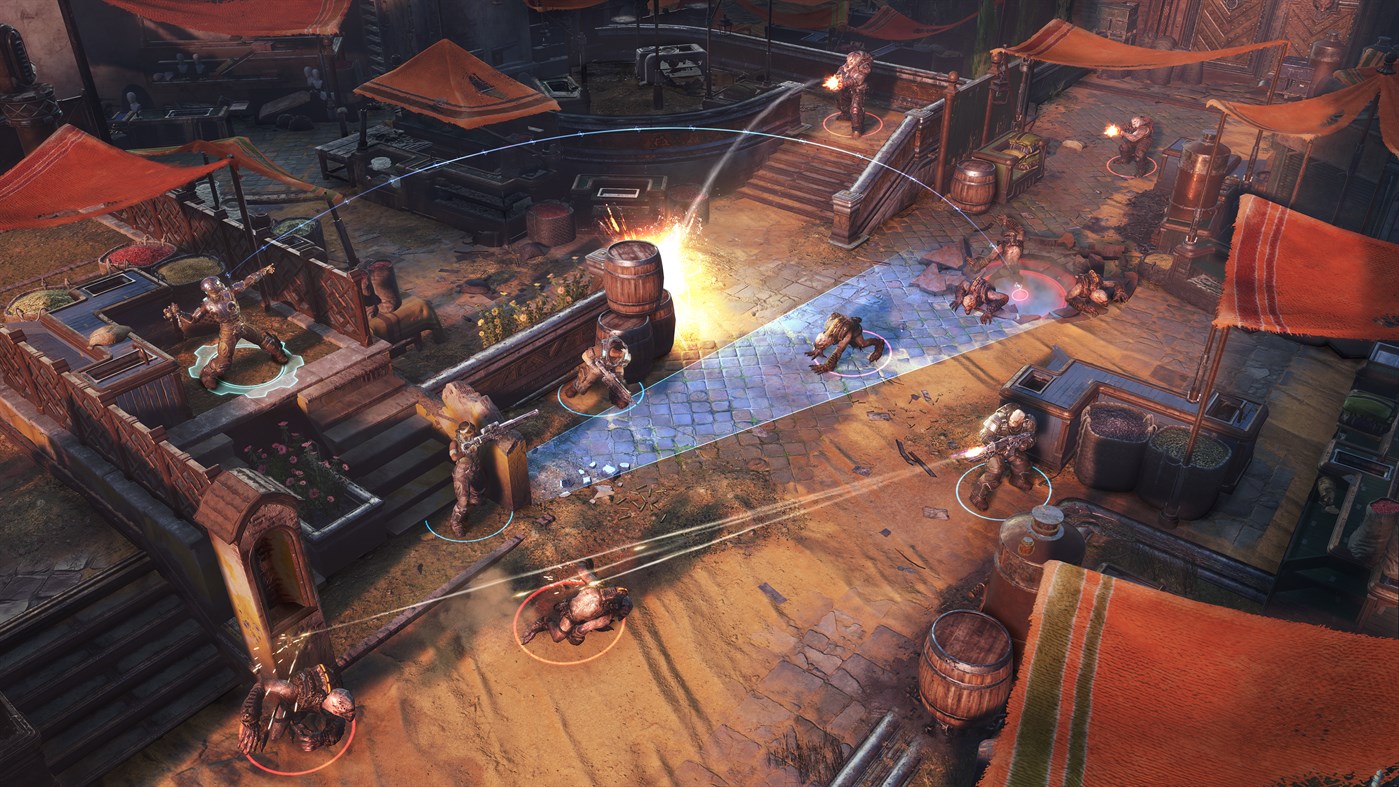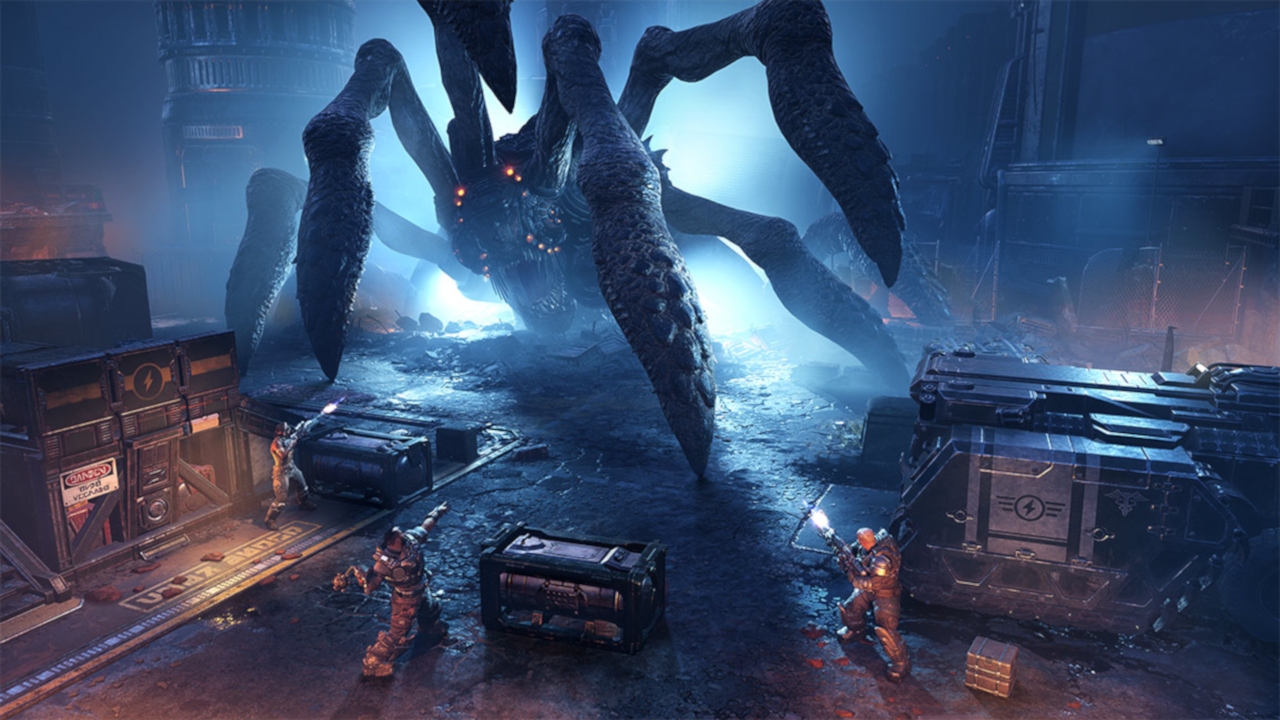Gears Tactics is the Gears of War spin-off that I didn’t know I wanted.
It is a refreshing departure for the series that manages to capture the essence of the Gears franchise in an entirely new genre.
Announced seemingly without significant fanfare, Gears Tactics is, as you can probably guess from the name, a squad-based tactical role playing game in the vein of XCOM. Though instead of aliens from outer space, your enemy now is the locust from deep under the ground.
In a way, a cover-based shooter is a smart opportunity for the similarly cover-friendly tactics genre. Both rely on establishing your position and responding to the enemies that appear, and where they come from. And while Gears Tactics feels sufficiently established in the world of the mainline Gears games, it doesn’t work to slavishly follow those games, which is much to its benefit. There’s the usual lancers, gnashers, knee high walls and impossibly burly fighters and they all are used in ways that contribute seem natural.

It is a fast-paced, polished, stripped back experience that forgoes some of the complexity the genre is renowned for to make sure each moment-to-moment gameplay decision is the most impactful on the fight at hand. If you’re looking for the mechanical complexity and depth of a XCOM or Phoenix Point, then this experience may not meet your expectations. But taken on the face of what it is, and what it’s trying to accomplish, it is a fantastic entry that takes some chances with new ideas while not straying too far from the fundamentals of the tacs genre.
Gears Tactics starts 10 years before Emergence Day, with the story of ex-Gears Gabe turned mechanic, who, when the planet is scorched with fire from the Hammer of Dawns in an attempt to wipe out the locusts, is forcibly re-enlisted into active service by older Gears Sid. It’s a typically schlocky, machismo story, full of hoorah while still questioning the motivations and skills of everyone in the chain of command higher than he is. Honestly there are more cutscenes and character development than I would have thought going in, which I welcomed, but this isn’t going to be a narrative that is discussed widely for years.

Instead a huge amount of time and effort has clearly been put into making the turn-to-turn tactical combat work great while fitting into the wider context. Every element of this game’s systems fit together well, with no obvious disconnects between them. For example, your home base (a convoy of vehicles) is entirely focused on character development and enhancing their loadouts. Unlike other games, there’s no metagame, sending out recruits for supplies or the like. It’s tightly focused on what happens during a mission.
Speaking of, I appreciated that missions are not too long and are relatively well checkpointed. Given this, the developers have limited save scumming to these checkpoints, which depending on your playstyle could be immensely frustrating, but to me were a very reasonable compromise.

On the battlefield itself you’ll manage your squad, which can be comprised of many of the standard types of troops typically found in tactics games. You have your standard grunt, a heavy, a scout with a shotgun, and a support. These are further split between hero characters and recruits. Some missions will bar you from certain characters, and others will restrict the number of troops you can take onto the battlefield. This kept each mission feeling fresh, which combined with innovative use of battlefield design made me eager to see what would be happening in each mission. I did find though I tended to use my hero characters more often, and a noticeable gap in skill levels opened up between those two types.
Each turn in Gears Tactics is defined by three (or more) actions. You can choose to move, shoot, set overwatch, toss a grenade or use one of the many special abilities each class type can develop as they level up. Synergistic use of these abilities will make Gears Tactics a much more survivable game, especially with the unusually large numbers of enemies that it will throw at you. You have freedom to use any of these actions in any order you like, so just because you’ve shot doesn’t mean you can’t move anymore, a decision that never has made any sense to me. This means, for example, Gabe can chainsaw or execute an enemy before running back to cover to be safe on the next turn.

Setting overwatch (where you automatically shoot enemies that enter a cone of vision during their attack phase) is even more of a critical component of Gears Tactics than usual. Each action that you don’t use during your normal turn is added to the number of times overwatch activates. This means you can set overwatch over an E-hole about to explode with enemies, and know that you’ll be able to do some decent damage right out of the gate. Combine this with the heavy’s bonus for not moving and you can clear out oncoming waves much more easily than if you were trying to pick off enemies one by one.
It would take thousands of words to talk about all the various mechanics and gameplay systems in Gears Tactics, but as should be clear this game is no rush job conversion of a popular franchise IP into a new genre. Microsoft has given the team time to make a fantastic tactical game that would work just as well without the iconic Gears world and characters, but gels so nicely with it that the end product seems natural. From the refined fog of war, weapon upgrade paths, passive and active abilities to the smart integration of the standard Gears enemies as specific enemy types Gears Tactics has been carefully considered in all aspects.

Technically, Gears Tactics ran fine on my Radeon 5700XT at 1440p and 60FPS. The graphics menu is a delight, and there’s a benchmark included as well. This is a first-class PC game and no mere console conversion as is sometimes the case, and alongside Gears 5 demonstrate The Coalition’s acumen in knowing how to approach building a PC-first game in 2020.
Of course it is impossible to talk about Gears Tactics without mentioning the surprise release of XCOM: Chimera Squad. Having played both games, I can say that I honestly prefer what Gears Tactics is doing. While Chimera Squad takes a couple of bolder stances in its gameplay and combat design, such as with the timeline, it retains some of the other, more standard conventions that Gears Tactics refines. Ultimately, both games are excellent and which you prefer may come down to individual game design and game flow choices made by the developers.

Gears Tactics is also a prettier game. At almost maximum settings it is gorgeous, mimicking the excellent presentation style of Gears 5, while still being suited to the isometric view of a tactics game. Worlds are detailed, lighting is on point, and character models are extremely highly detailed.
More of this please. With a renewed commitment to gaming, and especially the PC, Microsoft is demonstrating the fruit of its labour over the last few years buying studios and investing in games. The Coalition and Splash damage were clearly given significant time and budget to go out and create an experience that is no hack job or cheap port. And that is also demonstrated on the business side too – Gears Tactics is available on Steam day-and-date with its release on the Microsoft Store and Game Pass. I like this new Microsoft. It bodes well for the next generation of consoles and demonstrates a significant difference from Sony’s approach, doubling down on first-party exclusives.

Released: April 2020
Rating: M
Platforms: Xbox One, PC (Windows 10)
Genre: Strategy
Developer: The Coalition
Publisher: Microsoft






